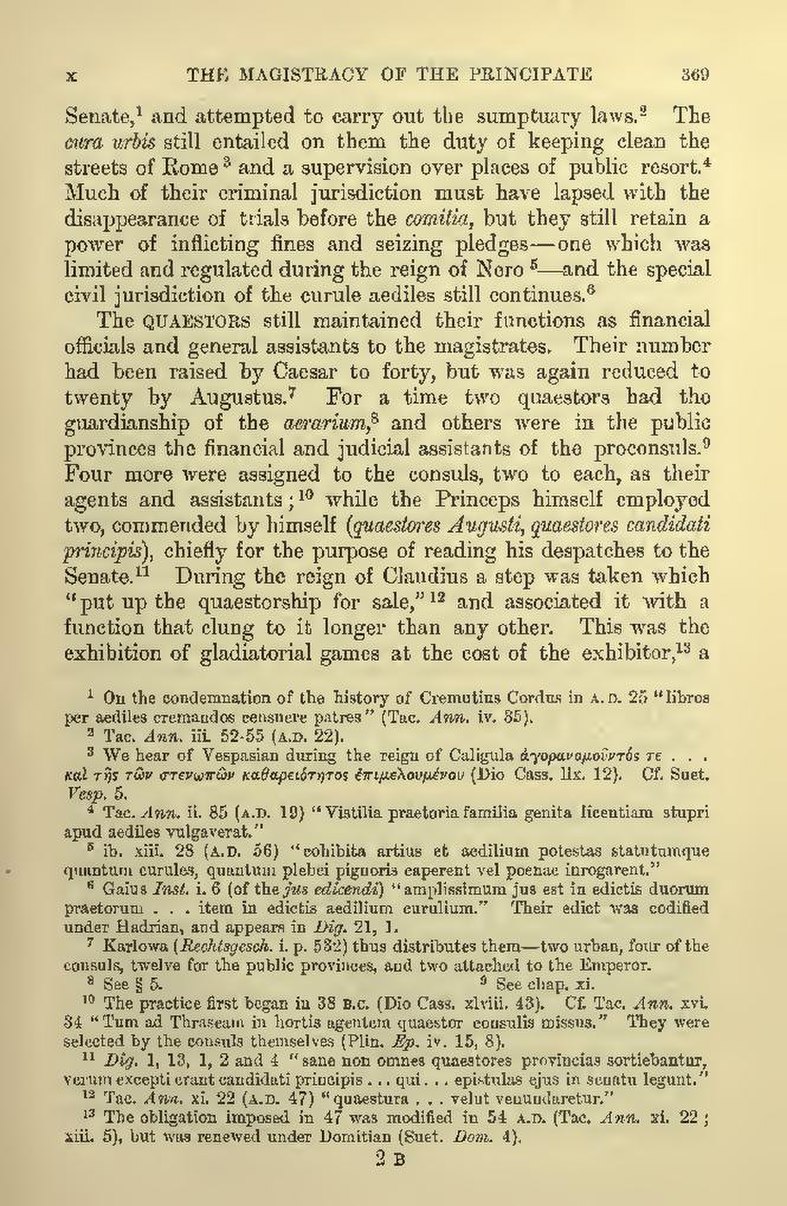Senate,[1] and attempted to carry out the sumptuary laws.[2] The cura urbis still entailed on them the duty of keeping clean the streets of Rome[3] and a supervision over places of public resort.[4] Much of their criminal jurisdiction must have lapsed with the disappearance of trials before the comitia, but they still retain a power of inflicting fines and seizing pledges—one which was limited and regulated during the reign of Nero[5]—and the special civil jurisdiction of the curule aediles still continues.[6]
The QUAESTORS still maintained their functions as financial officials and general assistants to the magistrates. Their number had been raised by Caesar to forty, but was again reduced to twenty by Augustus.[7] For a time two quaestors had the guardianship of the aerarium,[8] and others were in the public provinces the financial and judicial assistants of the proconsuls.[9] Four more were assigned to the consuls, two to each, as their agents and assistants;[10] while the Princeps himself employed two, commended by himself (quaestores Augusti, quaestores candidati principis), chiefly for the purpose of reading his despatches to the Senate.[11] During the reign of Claudius a step was taken which "put up the quaestorship for sale,"[12] and associated it with a function that clung to it longer than any other. This was the exhibition of gladiatorial games at the cost of the exhibitor,[13] a(Dio Cass. lix. 12). Cf. Suet. Vesp. 5.]
- ↑ On the condemnation of the history of Cremutius Cordus in A.D. 25 "libros per aediles cremandos censuere patres" (Tac. Ann. iv. 35).
- ↑ Tac. Ann. iii 52-55 (A.D. 22).
- ↑ We hear of Vespasian during the reign of Caligula [Greek: agoranomountos te . . . kai tês tôn stenôpôn kathareiotêtos epimeloumenou
- ↑ Tac. Ann. ii. 85 (A.D. 19) "Vistilia praetoria familia genita licentiam stupri apud aediles vulgaverat."
- ↑ ib. xiii. 28 (A.D. 56) "cohibita artius et aedilium potestas statutumque quantum curules, quantum plebei pignoris caperent vel poenae inrogarent."
- ↑ Gaius Inst. i. 6 (of the jus edicendi) "amplissimum jus est in edictis duorum praetorum . . . item in edictis aedilium curulium." Their edict was codified under Hadrian, and appears in Dig. 21, 1.
- ↑ Karlowa (Rechtsgesch. i. p. 532) thus distributes them—two urban, four of the consuls, twelve for the public provinces, and two attached to the Emperor.
- ↑ See § 5.
- ↑ See chap. xi.
